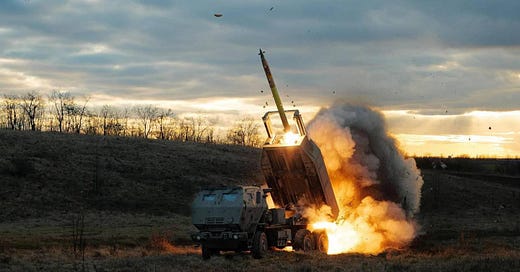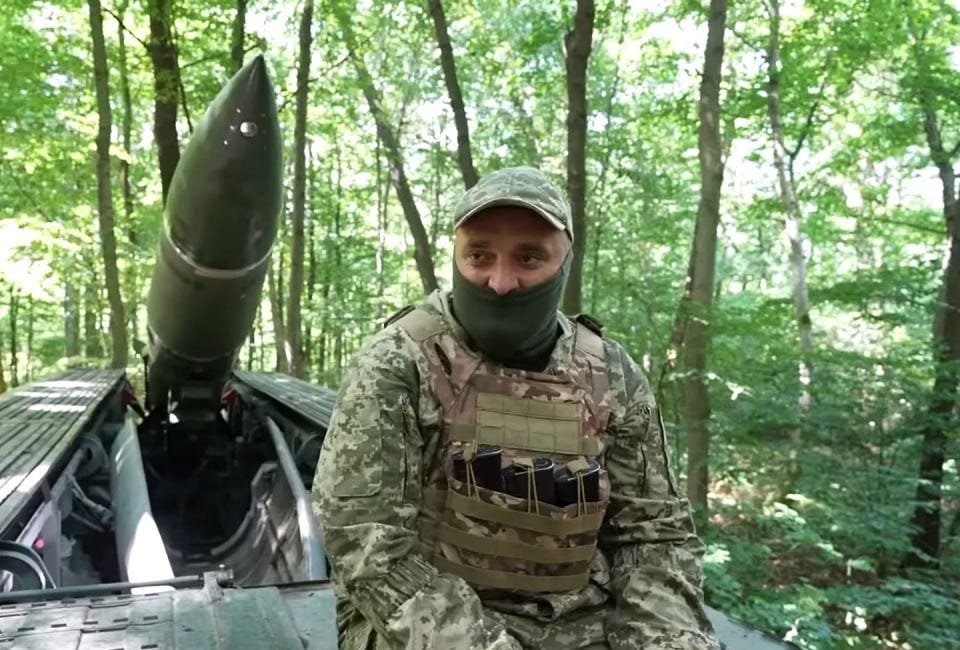For the Fifth Time This Year, Russians Gathered Out in the Open Within Range of Ukraine's HIMARS
What happened next was entirely predictable
For at least the fifth time this year, Russian troops gathered in large numbers, out in the open and in broad daylight, for training near the front line of Russia’s wider war on Ukraine—and within range of Ukraine’s American-made High-Mobility Artillery Rocket Systems.
On or just before Monday, seemingly dozens of Russians crowded together at what appeared to be a rifle range reportedly on the eastern front of the war. A Ukrainian drone observed the training—and at least two Ukrainian munitions, possibly M30/31 rockets packed with hundreds of thousands of tungsten balls, rained down.
The first munition struck a truck parked near the range, blowing it up and sending the trainees and their instructors running. A second munition exploded among the fleeing troops. It’s unclear how many Russians were killed or wounded.
But it is clear there’s a trend. Despite the obvious danger from the combination of surveillance drones and precision rockets—and despite several recent mass-casualty events—the Russians continue to conduct training and inspections near the front line.
On Feb. 20, a HIMARS strike targeted soldiers from the Russian army’s 39th Separate Guards Motor Rifle Brigade in Trudivs'ke in eastern Ukraine. Two companies of infantry had lined up along with their commander, Col. G. Musaev, so that Maj. Gen. Oleg Lvovich Moiseev, commander of the 29th Combined Arms Army, could address them.
Moiseev reportedly was en route when a Ukrainian drone arrived overhead, and a HIMARS opened fire. The front line is just 20 miles to the west, around Vuhledar. A HIMARS can lob M30/31 rockets as far as 57 miles.
Reportedly 65 soldiers died, including Musaev. “They lined them up in an open field,” one survivor groused as he recorded the carnage. “Fucking commanders.”
The next day, it happened again. Two separate formations from the Russian 328th Air Assault Regiment, 810th Guards Naval Infantry Brigade and 81st Self-Propelled Artillery Regiment assembled for an apparent inspection in the Oleshky Sands National Nature Park, in southern Ukraine 20 miles south of the Dnipro River.
A Ukrainian drone located them. Ukrainian artillery—perhaps HIMARS—took aim. Another 60 or so Russians reportedly died.
Six days later on Feb. 27, Russian marines from the 155th Naval Infantry Brigade gathered for an inspection in Olenivka, eight miles east of the front line in eastern Ukraine.
Two Ukrainian M30/31s streaked down. Reportedly 19 Russians died including a colonel and two other officers. The brigade commander, Col. Mikhail Gudkov, was wounded.
The Russians got as short reprieve. On May 1, hundreds of Russians assembled outside near Kuban, a settlement in Luhansk Oblast in eastern Ukraine, 60 miles from the front line.
As the Russians milled about in broad daylight and a Ukrainian drone observed from high overhead, a HIMARS battery fired four Army Tactical Missile System rockets—American-made precision-guided ballistic missiles that, depending on the model, range as far as 190 miles and scatter hundreds of grenade-size submunitions.
One ATACMS failed to explode. The other three popped open and scattered their lethal payloads. Each rocket turned an area as wide as 2.5 acres into a nearly inescapable kill zone. All 116 Russians may have died in the rain of submunitions, according to the Institute for the Study of War in Washington, D.C.
Read more:
The Ukrainian Army Got a Fresh Batch of Tochka-U Ballistic Missiles. Expect Attacks Along the Russian Border.
The Ukrainian army’s sole Tochka-U missile brigade is back in action.







Don't interrupt the enemy while they are making mistakes. Don't inform them either.